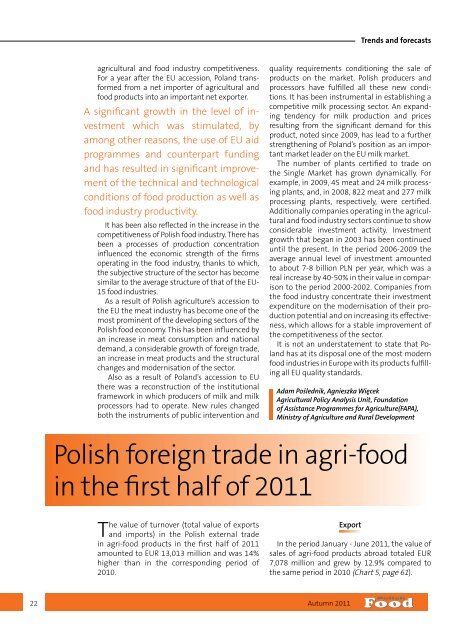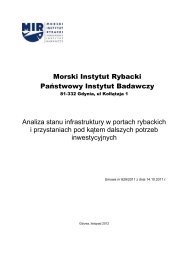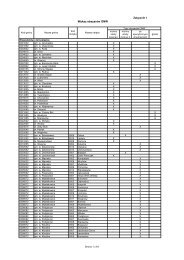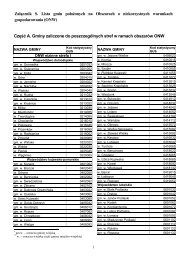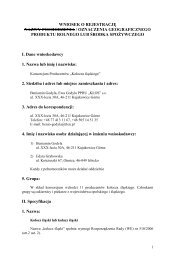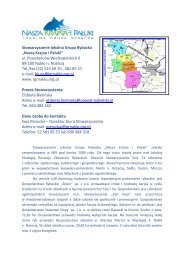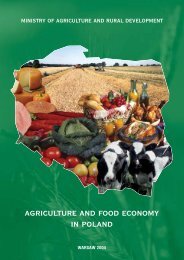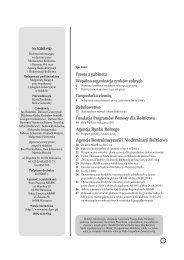download file
download file
download file
You also want an ePaper? Increase the reach of your titles
YUMPU automatically turns print PDFs into web optimized ePapers that Google loves.
Trends and forecasts<br />
agricultural and food industry competitiveness.<br />
For a year after the EU accession, Poland transformed<br />
from a net importer of agricultural and<br />
food products into an important net exporter.<br />
A significant growth in the level of investment<br />
which was stimulated, by<br />
among other reasons, the use of EU aid<br />
programmes and counterpart funding<br />
and has resulted in significant improvement<br />
of the technical and technological<br />
conditions of food production as well as<br />
food industry productivity.<br />
It has been also reflected in the increase in the<br />
competitiveness of Polish food industry. There has<br />
been a processes of production concentration<br />
influenced the economic strength of the firms<br />
operating in the food industry, thanks to which,<br />
the subjective structure of the sector has become<br />
similar to the average structure of that of the EU-<br />
15 food industries.<br />
As a result of Polish agriculture’s accession to<br />
the EU the meat industry has become one of the<br />
most prominent of the developing sectors of the<br />
Polish food economy. This has been influenced by<br />
an increase in meat consumption and national<br />
demand, a considerable growth of foreign trade,<br />
an increase in meat products and the structural<br />
changes and modernisation of the sector.<br />
Also as a result of Poland’s accession to EU<br />
there was a reconstruction of the institutional<br />
framework in which producers of milk and milk<br />
processors had to operate. New rules changed<br />
both the instruments of public intervention and<br />
quality requirements conditioning the sale of<br />
products on the market. Polish producers and<br />
processors have fulfilled all these new conditions.<br />
It has been instrumental in establishing a<br />
competitive milk processing sector. An expanding<br />
tendency for milk production and prices<br />
resulting from the significant demand for this<br />
product, noted since 2009, has lead to a further<br />
strengthening of Poland’s position as an important<br />
market leader on the EU milk market.<br />
The number of plants certified to trade on<br />
the Single Market has grown dynamically. For<br />
example, in 2009, 45 meat and 24 milk processing<br />
plants, and, in 2008, 822 meat and 277 milk<br />
processing plants, respectively, were certified.<br />
Additionally companies operating in the agricultural<br />
and food industry sectors continue to show<br />
considerable investment activity. Investment<br />
growth that began in 2003 has been continued<br />
until the present. In the period 2006-2009 the<br />
average annual level of investment amounted<br />
to about 7-8 billion PLN per year, which was a<br />
real increase by 40-50% in their value in comparison<br />
to the period 2000-2002. Companies from<br />
the food industry concentrate their investment<br />
expenditure on the modernisation of their production<br />
potential and on increasing its effectiveness,<br />
which allows for a stable improvement of<br />
the competitiveness of the sector.<br />
It is not an understatement to state that Poland<br />
has at its disposal one of the most modern<br />
food industries in Europe with its products fulfilling<br />
all EU quality standards.<br />
Adam Poślednik, Agnieszka Więcek<br />
Agricultural Policy Analysis Unit, Foundation<br />
of Assistance Programmes for Agriculture(FAPA),<br />
Ministry of Agriculture and Rural Development<br />
Polish foreign trade in agri-food<br />
in the first half of 2011<br />
The value of turnover (total value of exports<br />
and imports) in the Polish external trade<br />
in agri-food products in the first half of 2011<br />
amounted to EUR 13,013 million and was 14%<br />
higher than in the corresponding period of<br />
2010.<br />
Export<br />
In the period January - June 2011, the value of<br />
sales of agri-food products abroad totaled EUR<br />
7,078 million and grew by 12.9% compared to<br />
the same period in 2010 (Chart 5, page 61).<br />
22<br />
Autumn 2011


